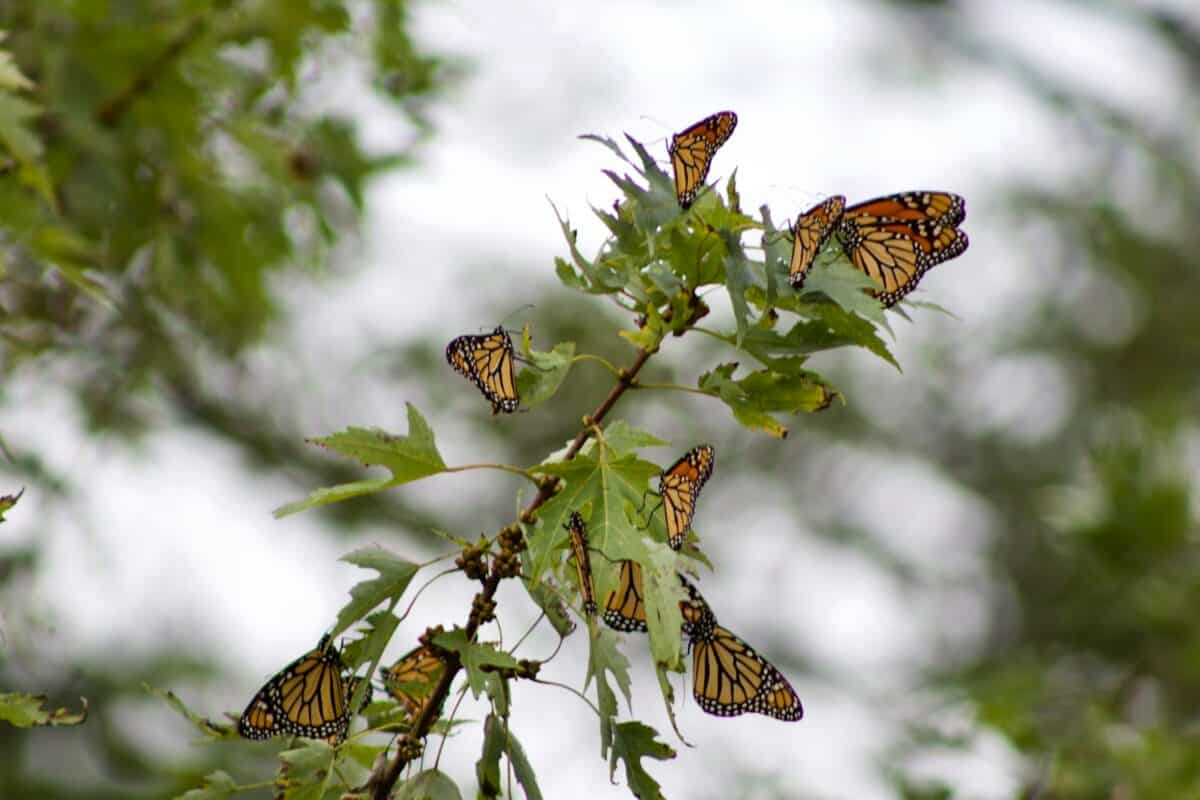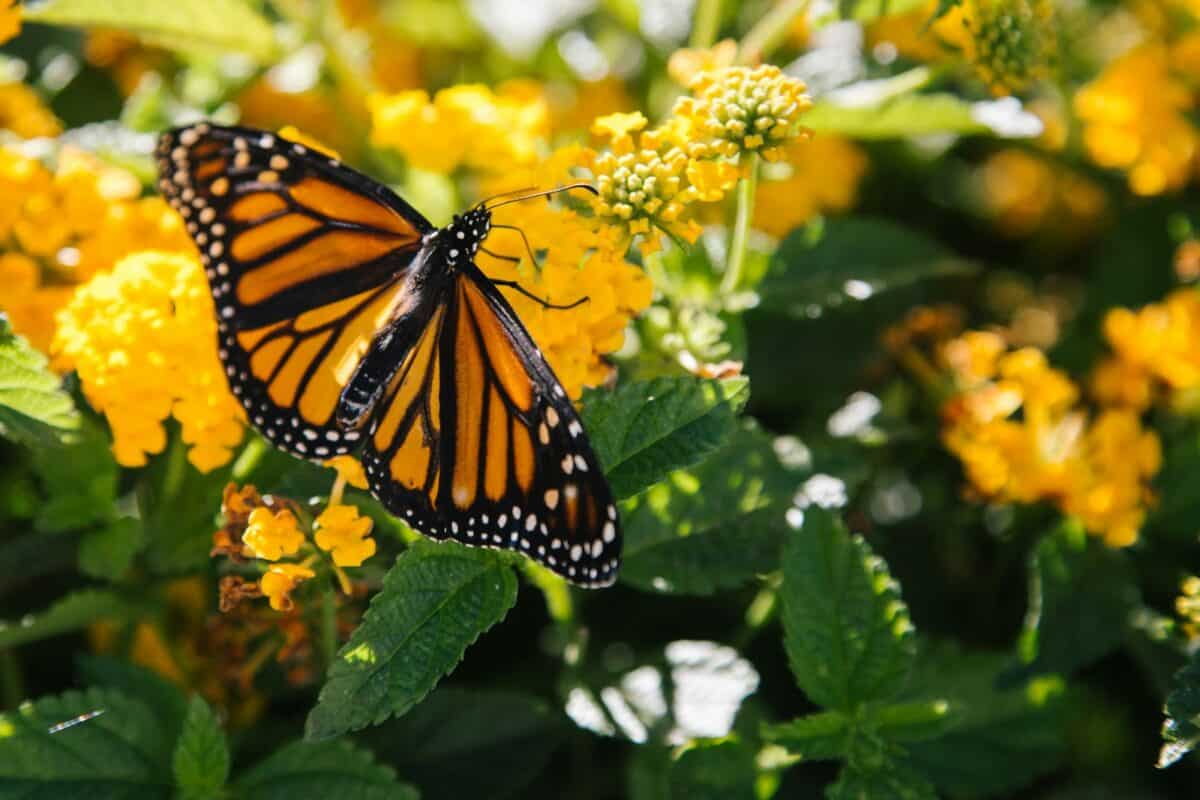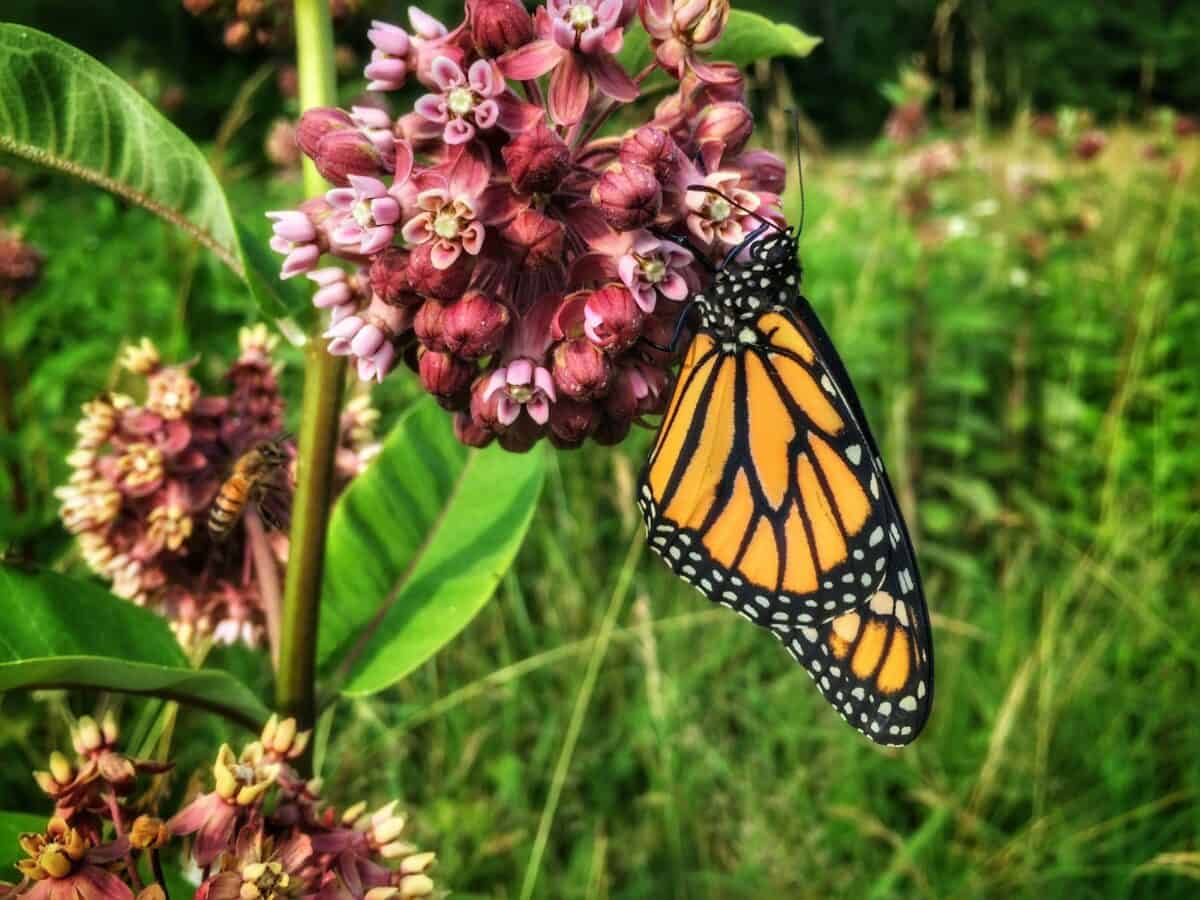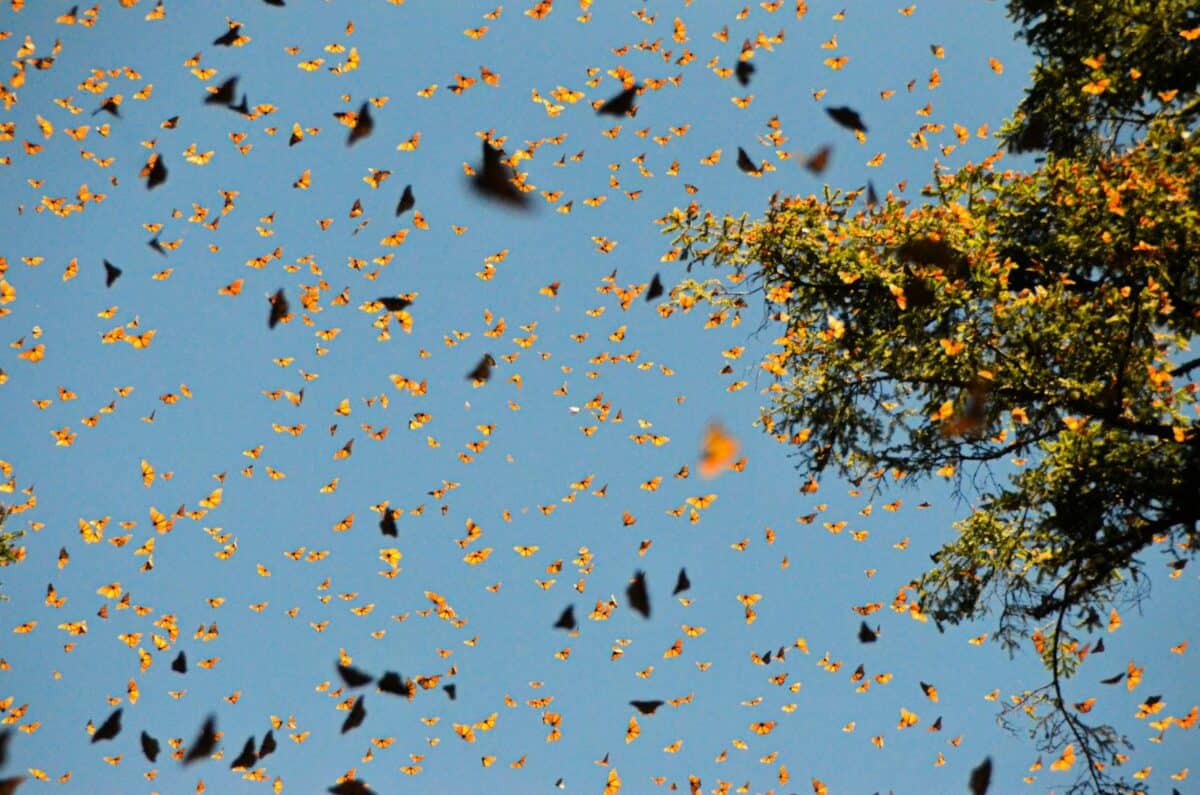In the world of animal migrations, birds, whales, and caribou often steal the spotlight. Yet, fluttering among these giants of endurance is an unlikely champion: the Monarch butterfly (Danaus plexippus). Weighing less than a paperclip and sporting vibrant orange wings, this remarkable insect undertakes a migration so vast and challenging that it defies our understanding of what such a delicate creature should be capable of. Every year, millions of Monarchs embark on an epic journey spanning thousands of miles, traversing mountains, deserts, and even parts of the Gulf of Mexico. This migration represents not just a remarkable feat of navigation and endurance but a multi-generational relay race that has captivated scientists and nature enthusiasts for centuries. Let’s explore the extraordinary migration of the Monarch butterfly – the insect that travels further than any other butterfly on Earth – and the challenges it faces in our rapidly changing world.
The Monarch Butterfly’s Identity: Nature’s Long-Distance Champion

The Monarch butterfly (Danaus plexippus) stands out among the estimated 20,000 butterfly species worldwide as the undisputed king of migration. With its distinctive orange wings laced with black veins and bordered with white spots, this medium-sized butterfly has become one of North America’s most recognizable insects. Adult Monarchs typically weigh between 0.25 and 0.75 grams – about as much as a paperclip – and have a wingspan of approximately 3.5 to 4 inches. Despite their delicate appearance, these insects possess remarkable physiological adaptations that enable them to undertake journeys spanning up to 3,000 miles. Their wings, particularly strong for a butterfly, allow for extended gliding during migration, while specialized fat reserves provide the necessary fuel for their marathon journey. Beyond their migratory prowess, Monarchs have evolved chemical defenses by sequestering toxic compounds from milkweed plants they consume as caterpillars, making them unpalatable to most predators. This combination of migratory ability and defensive adaptation has helped the Monarch become one of the most successful and widely distributed butterfly species in the world.
The Epic Migration: A Journey of Thousands of Miles

The Monarch’s migration is truly one of nature’s most spectacular phenomena. Each fall, Monarchs in North America embark on an extraordinary journey that can span up to 3,000 miles, from as far north as Canada to overwintering grounds in central Mexico or, for some western populations, to sites along the California coast. What makes this migration particularly remarkable is that unlike birds or mammals, individual butterflies don’t complete the round trip. Instead, it’s a multi-generational relay race. The butterflies that leave the northern regions in autumn are typically four or five generations removed from those that made the northward journey the previous spring. Despite never having made the journey before, these butterflies navigate with remarkable precision to the same overwintering sites used by their ancestors. During this migration, Monarchs can travel between 50-100 miles per day, riding thermal currents to conserve energy and maximize distance. They navigate using a combination of directional aids, including the position of the sun and Earth’s magnetic field. This migratory marvel represents the longest known migration of any insect species and stands as one of the most impressive feats in the animal kingdom.
A Biological Marvel: How Monarchs Navigate Without Maps

The navigation capabilities of migrating Monarchs have long puzzled scientists and represent one of nature’s most sophisticated biological compasses. Unlike humans who rely on maps or GPS, Monarchs possess an internal guidance system that combines multiple sensory inputs. Research has revealed that Monarchs use a time-compensated sun compass, meaning they can track the sun’s position throughout the day and adjust their course accordingly, even accounting for the sun’s movement across the sky. This biological clock is located in their antennae, not just their brain as previously thought. Beyond solar navigation, Monarchs also detect Earth’s magnetic field through cryptochrome proteins in their antennae, providing a backup navigation system on cloudy days. Perhaps most remarkably, these butterflies seem to possess a genetic memory that guides them to specific overwintering sites – places they’ve never been before but where their ancestors gathered for countless generations. This combination of celestial, magnetic, and genetic navigation enables a creature with a brain the size of a pinhead to complete one of nature’s most impressive journeys without a single wrong turn – a feat that continues to inspire both scientific research and genuine awe.
The Mexican Highlands: Journey’s End for Millions

After their grueling migration southward, the majority of North America’s eastern Monarch population – an estimated 100-200 million butterflies – converges on a remarkably small and specific area: the oyamel fir forests in the Transvolcanic Mountains of central Mexico. This region, encompassing just 12 known overwintering sites within an area of approximately 70 square miles, becomes home to dense congregations of Monarchs from November through March. The selection of these particular forests is far from random. The oyamel fir forests exist in a narrow ecological band at elevations between 2,400 and 3,600 meters, providing the perfect microclimate for overwintering butterflies. These forests maintain relatively stable temperatures – cool enough to slow the butterflies’ metabolism and conserve their limited fat reserves, but not so cold as to freeze them. The high humidity also prevents dehydration. During winter, Monarchs enter a state similar to hibernation, clustering by the thousands on tree trunks and branches. These clusters can become so dense that branches sometimes break under their weight, with up to 15,000 butterflies per square meter. The sight of millions of Monarchs covering the forest has been described as one of nature’s most awe-inspiring spectacles and became a UNESCO World Heritage Site in 2008 in recognition of its biological importance.
The California Coast: The Western Monarch’s Winter Haven

While the majority of North American Monarchs migrate to Mexico, a smaller, genetically distinct western population follows a different path. These butterflies, which breed west of the Rocky Mountains, make a shorter but still impressive migration to overwintering sites along the California coast, primarily between Mendocino County and Baja California. Unlike the consolidated Mexican sites, the western Monarch population disperses among over 400 known overwintering locations scattered along the Pacific coastline. These sites typically feature groves of eucalyptus, Monterey pine, or Monterey cypress trees that provide the perfect combination of shelter from winter storms while allowing enough sunlight for warmth. Historically, the western Monarch population numbered in the millions, with famous overwintering sites like Pacific Grove, Santa Cruz, and Pismo Beach hosting tens of thousands of butterflies that attracted visitors from around the world. The western migration route is generally shorter than the eastern one, with butterflies traveling between 500 and 1,000 miles to reach their wintering grounds. However, this population has suffered particularly severe declines in recent decades, with a catastrophic 99.9% drop from the millions that once overwintered in California to fewer than 2,000 butterflies counted in 2020, though numbers have shown some recovery since. The dramatic decline of western Monarchs serves as a stark indicator of the challenges facing these migratory insects.
The Spring Return: A Multi-Generational Relay Race

The Monarch’s return journey northward in spring differs dramatically from their fall migration and represents one of the most fascinating multi-generational wildlife phenomena on the planet. As temperatures warm in March, overwintering Monarchs become active, mate, and begin flying northward. Unlike the fall migration accomplished by a single generation, the spring return is a relay race spanning three to four generations of butterflies. The overwintering Monarchs, already 6-8 months old – ancient by butterfly standards – travel part of the way north, lay eggs on emerging milkweed plants, and then die. Their offspring continue the northward journey, with each successive generation pushing the migration frontier further north until Monarchs once again reach the northern United States and southern Canada by early summer. Each generation in this relay lives only about 2-5 weeks as adults, with their brief lives dedicated to reproduction and continuing the migration. This multi-generational strategy allows Monarchs to take advantage of the progressive emergence of milkweed across latitudes as spring advances northward. Scientists remain puzzled about how these butterflies, separated by multiple generations from those that made the southward journey, know to return to the same northern breeding grounds their great-great-grandparents left the previous fall. This remarkable phenomenon demonstrates how migration can be encoded not just in individual memory but within the genetic heritage of an entire species.
Milkweed: The Essential Host Plant

The Monarch butterfly’s existence is inextricably linked to milkweed plants (Asclepias species), forming one of nature’s most specialized plant-insect relationships. Milkweed serves as the exclusive host plant for Monarch caterpillars – they cannot feed on any other plant. This specialization shapes every aspect of the Monarch’s life cycle and migration pattern. Female Monarchs lay their eggs individually on milkweed leaves, and upon hatching, the caterpillars feed exclusively on milkweed for 2-3 weeks before pupating. Milkweed contains toxic compounds called cardiac glycosides, which Monarch caterpillars have evolved to tolerate and sequester in their bodies. These toxins remain in the butterflies through metamorphosis, making adult Monarchs unpalatable to many predators – a defense mechanism advertised by their bright orange warning coloration. The distribution of milkweed across North America directly influences the Monarch’s migration routes, with butterflies following what scientists call “milkweed corridors” during their spring northward journey. Historically, milkweed was abundant across the American landscape, particularly in the agricultural Midwest. However, modern farming practices, including the widespread use of herbicides on herbicide-resistant crops, have eliminated milkweed from millions of acres of farmland. This reduction in milkweed availability is considered one of the primary factors in the Monarch’s population decline, highlighting how the fate of this remarkable butterfly is tied to a single genus of plants.
Population Decline: A Butterfly in Crisis

The Monarch butterfly, despite its remarkable adaptability and migratory prowess, faces an unprecedented crisis. Over the past two decades, North American Monarch populations have declined by approximately 80%, triggering alarm among scientists and conservationists. The eastern migratory population, which overwinters in Mexico, has dropped from an estimated 1 billion butterflies in the mid-1990s to often fewer than 100 million in recent years. The decline has been even more catastrophic for the western population that overwinters in California, which has collapsed by more than 99% since the 1980s, reaching a historic low of fewer than 2,000 butterflies in the winter of 2020-2021. This precipitous decline stems from multiple interconnected threats. Habitat loss remains the primary concern, with an estimated 167 million acres of breeding and milkweed habitat lost in the United States due to land development and agricultural practices since the 1990s. Climate change has disrupted the delicate timing of migration and altered weather patterns, sometimes causing catastrophic mortality events at overwintering sites. Pesticide use, particularly neonicotinoid insecticides, has further reduced Monarch survival rates. The combined impact of these threats has been so severe that in December 2020, the U.S. Fish and Wildlife Service determined that listing the Monarch as an endangered species was “warranted but precluded” by higher priority actions – essentially acknowledging the butterfly’s dire situation while deferring formal protection measures.
Conservation Efforts: Saving the Marathon Migrant

In response to the Monarch’s alarming decline, an unprecedented continental conservation effort has emerged, spanning government agencies, non-profits, researchers, and ordinary citizens across North America. The scale of these efforts matches the continental range of the butterfly itself. In 2015, the United States launched a National Strategy to Promote the Health of Honey Bees and Other Pollinators, which included specific goals for Monarch conservation, including the restoration of sufficient habitat to support a population of 225 million butterflies. Mexico has strengthened protection of overwintering sites, expanding the Monarch Butterfly Biosphere Reserve to over 56,000 hectares. Meanwhile, Canada has developed its own national conservation plan. Beyond governmental action, numerous non-profit organizations have mobilized around Monarch conservation. The Monarch Joint Venture coordinates conservation efforts across the United States, while the Xerces Society leads scientific monitoring and advocacy. Perhaps most remarkably, citizen science projects have engaged tens of thousands of volunteers in Monarch conservation. The Monarch Larva Monitoring Project and Journey North allow ordinary people to contribute valuable scientific data, while initiatives like the Monarch Waystation program have inspired the creation of over 30,000 registered Monarch habitats in home gardens, schools, and public spaces. These community-based efforts represent one of the largest grassroots conservation movements in North American history, demonstrating how the Monarch’s plight has captured public imagination and concern.
Climate Change: New Challenges for an Ancient Migration

Climate change presents perhaps the most complex and unpredictable threat to the Monarch’s migration, potentially disrupting a journey that has evolved over thousands of years. Rising temperatures and changing precipitation patterns are already altering the delicate timing between Monarch migration and milkweed emergence. When spring arrives earlier, Monarchs may begin their northward journey before sufficient milkweed has emerged, creating a dangerous mismatch between the butterfly’s lifecycle and its essential host plant. Conversely, warmer fall temperatures may delay the environmental cues that trigger the southward migration, potentially causing butterflies to depart too late to reach their overwintering grounds before deadly frosts occur. Extreme weather events, which are increasing in frequency and intensity with climate change, pose additional dangers. Severe droughts can reduce milkweed abundance and quality, while powerful storms can directly kill migrating butterflies. Perhaps most concerning are the threats to overwintering sites. In Mexico, climate models predict that the specific microclimate conditions required by overwintering Monarchs—consistent cool temperatures with high humidity—may disappear from current sanctuary areas by the end of the century as mountain ecosystems warm. Similarly, California’s coastal overwintering sites face threats from sea level rise and changing coastal climates. Unlike habitat loss, which can be addressed through restoration efforts, climate change may fundamentally alter environmental conditions in ways that make the Monarch’s traditional migration routes and destinations unviable, forcing this remarkable butterfly to adapt to new patterns or face extinction.
The Butterfly Effect: Why Monarchs Matter

The significance of the Monarch butterfly extends far beyond its stunning appearance and remarkable migration. As a flagship species, the Monarch serves as an ambassador for countless less charismatic insects and pollinators facing similar threats. Its decline represents a visible indicator of broader environmental changes affecting ecosystems across North America. Ecologically, Monarchs contribute to plant reproduction through pollination services, though not as significantly as bees and other primary pollinators. Their caterpillars’ exclusive dependence on milkweed highlights the importance of specialized plant-insect relationships in maintaining biodiversity. Moreover, Monarchs represent an important food source for various predators, from birds to insects, forming a link in complex food webs. Beyond ecological value, Monarchs hold tremendous cultural significance across their range. In Mexico, they feature prominently in Day of the Dead celebrations, with their arrival coinciding with the holiday and traditionally believed to represent the souls of departed ancestors returning to visit. In the United States and Canada, Monarchs serve as powerful educational tools, helping millions of children learn about insect metamorphosis, migration, and conservation. Perhaps most profoundly, the Monarch’s migration represents one of the few remaining continental-scale wildlife phenomena in North America, connecting landscapes, ecosystems, and human communities across thousands of miles. In this capacity, the Monarch serves as a natural ambassador, demonstrating how environmental protection requires international cooperation across political boundaries.
The Monarch butterfly’s epic migration stands as one of nature’s most extraordinary phenomena – a testament to the remarkable adaptability and resilience encoded in even the smallest creatures. From the oyamel forests of Mexico to the meadows of Canada, these delicate insects connect continents and cultures through their marathon journey. Yet the future of this migration hangs in precarious balance, threatened by habitat loss, climate change, and agricultural practices that have already diminished Monarch populations by over 80% in recent decades. The response to this crisis offers both caution and hope – while government action has often moved slowly, an unprecedented grassroots movement has emerged, with tens of thousands of ordinary citizens planting milkweed, monitoring populations, and advocating for butterfly-friendly policies. The Monarch’s
- 10 Unique Animal Species That Can Only Be Found in the United States - August 15, 2025
- 10 Amazing Animals You Can Only Find in the United States - August 15, 2025
- 10 Times Tornadoes Flattened Entire Towns in the Midwest - August 15, 2025

